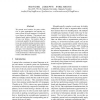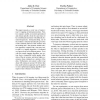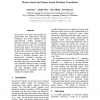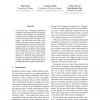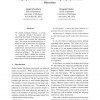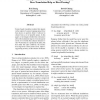ACL
2012
12 years 1 months ago
2012
We present novel metrics for parse evaluation in joint segmentation and parsing scenarios where the gold sequence of terminals is not known in advance. The protocol uses distance-...
ACL
2012
12 years 1 months ago
2012
Previous work using topic model for statistical machine translation (SMT) explore topic information at the word level. However, SMT has been advanced from word-based paradigm to p...
ACL
2012
12 years 1 months ago
2012
This paper presents a novel way of improving POS tagging on heterogeneous data. First, two separate models are trained (generalized and domain-specific) from the same data set by...
ACL
2012
12 years 1 months ago
2012
We present a new open source toolkit for phrase-based and syntax-based machine translation. The toolkit supports several state-of-the-art models developed in statistical machine t...
ACL
2012
12 years 1 months ago
2012
We present UWN, a large multilingual lexical knowledge base that describes the meanings and relationships of words in over 200 languages. This paper explains how link prediction, ...
ACL
2012
12 years 1 months ago
2012
Our research aims at building computational models of word meaning that are perceptually grounded. Using computer vision techniques, we build visual and multimodal distributional ...
ACL
2012
12 years 1 months ago
2012
We present Subgroup Detector, a system for analyzing threaded discussions and identifying the attitude of discussants towards one another and towards the discussion topic. The sys...
ACL
2012
12 years 1 months ago
2012
This paper studies the problem of sentencelevel semantic coherence by answering SATstyle sentence completion questions. These questions test the ability of algorithms to distingui...
ACL
2012
12 years 1 months ago
2012
Metaphors pervade our language because they are elastic enough to allow a speaker to express an affective viewpoint on a topic without committing to a specific meaning. This balan...
ACL
2012
12 years 1 months ago
2012
Syntax-based translation models that operate on the output of a source-language parser have been shown to perform better if allowed to choose from a set of possible parses. In thi...
